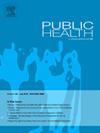抗菌药物处方评估工具 (AmPAT) 的开发和验证,用于评估印度初级和二级医疗机构中抗菌药物处方的合理性。
IF 3.9
3区 医学
Q1 PUBLIC, ENVIRONMENTAL & OCCUPATIONAL HEALTH
引用次数: 0
摘要
目的:无指征处方抗菌药会导致抗菌药耐药性(AMR)。本研究旨在开发一种经过验证的支持和审计抗菌药物处方评估工具(AmPAT),以评估初级和二级医疗机构门诊环境中全科医生处方的合理性:研究设计:多阶段内容效度研究:AmPAT 分四个阶段开发。第一阶段是根据文献和专家建议确定和开发项目。在第二阶段,采用德尔菲技术分两轮对表面效度和内容效度进行评估(第一轮16名专家,第二轮19名专家)。计算了内容效度比(CVR)和内容效度指数(CVI)。第 3 阶段在印度昌迪加尔的一级和二级医疗机构进行了试点研究(n = 92 张处方)。五位专家对 30 份处方的合理性进行了评估,以获得评分者间的可靠性。评分者之间的一致性和内部一致性分别采用 Fleiss-Kappa 统计法和 Cronbach's alpha 计算。第 4 阶段包括一项大型横断面研究(n = 945 个处方),以估计 AmPAT 的内部一致性:结果:AmPAT 包含三个部分(患者、临床和治疗细节)共 19 个项目。平均 CVR 为 0.91(范围为 0.16-1.00),平均 CVI 为 0.96(范围为 0.58-1.00)。评分者之间的一致性卡帕值为 0.91(范围 0.59-1.00)。第 3 和第 4 阶段的 Cronbach's alpha 分别为 0.75(95%CI 0.66-0.82)和 0.76(0.68-0.82):AmPAT具有良好的可靠性、评分者之间的一致性和内部一致性,可用于评估基层和二级医疗机构门诊处方抗菌药物的合理性。本文章由计算机程序翻译,如有差异,请以英文原文为准。
Antimicrobial Prescription Assessment Tool (AmPAT) development and validation for assessing the rationality of antimicrobial prescriptions in primary and secondary healthcare settings in India
Objectives
Antimicrobials prescribed without indications can lead to antimicrobial resistance (AMR). This study aimed to develop a validated support and audit antimicrobial prescription assessment tool (AmPAT) to assess the rationality of prescriptions by generalist medical doctors in outpatient settings at primary and secondary healthcare facilities.
Study design
Multiphase content validity study.
Methods
AmPAT was developed in four phases. Phase 1 involved item identification and development based on literature and expert suggestions. In phase 2, the face and content validity were assessed using the Delphi technique in two rounds (16 experts in round 1 and 19 in round 2). The content validity ratio (CVR) and content validity index (CVI) were calculated. A pilot study was conducted in Phase 3 in primary and secondary-level healthcare facilities (n = 92 prescriptions) in Chandigarh, India. Five experts assessed the rationality of 30 prescriptions for inter-rater reliability. The inter-rater agreement and internal consistency were calculated using Fleiss-Kappa statistics and Cronbach's alpha, respectively. Phase 4 included a large cross-sectional study (n = 945 prescriptions) for estimating the internal consistency of AmPAT.
Results
AmPAT was developed with 19 items under three sections (patient, clinical, and treatment details). The mean CVR was 0.91 (range 0.16–1.00), and mean CVI was 0.96 (range 0.58–1.00). The kappa value was 0.91 (range 0.59–1.00) for inter-rater agreement. The Cronbach's alpha was 0.75 (95%CI 0.66–0.82) and 0.76 (0.68–0.82) in phases 3 and 4, respectively.
Conclusion
AmPAT, with good reliability, inter-rater agreement, and internal consistency, was developed to assess the rationality of antimicrobials prescribed in outpatient departments at primary and secondary-level healthcare settings.
求助全文
通过发布文献求助,成功后即可免费获取论文全文。
去求助
来源期刊

Public Health
医学-公共卫生、环境卫生与职业卫生
CiteScore
7.60
自引率
0.00%
发文量
280
审稿时长
37 days
期刊介绍:
Public Health is an international, multidisciplinary peer-reviewed journal. It publishes original papers, reviews and short reports on all aspects of the science, philosophy, and practice of public health.
 求助内容:
求助内容: 应助结果提醒方式:
应助结果提醒方式:


